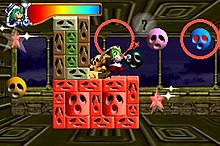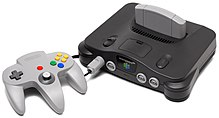Mischief Makers
| Mischief Makers | |
|---|---|
Single-player |
Mischief Makers
It is the first 2D side-scrolling game for the Nintendo 64, and Treasure's first release for a Nintendo console. The 12-person team began development in mid-1995 with little knowledge of the prototype console. The team wanted to make a novel gameplay mechanic, and implementing the resultant "catching" technique became their most difficult task. The game was announced at the 1997
Mischief Makers received mixed reviews. Critics praised its inventiveness, personality, and
Gameplay

Mischief Makers is the first
The
The game has five worlds with roughly twelve
Almost all things on Planet Clancer—including people, buildings, and pets—either wear or are inscribed with identical "sad" faces with red, glowing eyes.
Development

Treasure's founders had come from
The game is Treasure's first to have been published by Enix. The publisher sought Treasure for its reputation in the action game genre, and had approached Treasure several times before the Nintendo 64 project surfaced. Treasure CEO Maegawa was already fond of Enix, having applied unsuccessfully to work there as a student.[11] Upon choosing the Nintendo 64, Treasure thought it would be a "good idea" to work with Enix.[11] Similar to how Treasure ended its historic loyalty to the Sega Genesis by developing Mischief Makers for Nintendo, Enix had just recently ended its historic loyalty to Nintendo by signing Dragon Quest VII of its Dragon Quest franchise to Sony. Neither Square or Enix built a "special relationship" with Nintendo specific for Mischief Makers's release,[11] though Nintendo was the publisher for Western markets.[12] Prior to Nintendo proposing to publish the game in the West, Enix said it had no plans to release it outside Japan.[13] When its English localization finished ahead of schedule, the North American release date was advanced two weeks.[5]
Mischief Makers was the only game displayed at the Enix booth at the April 1997 Tokyo Game Show.
Reception
| Aggregator | Score |
|---|---|
Nintendo Life | |
| Nintendo Power | 6.9/10[4] |
Mischief Makers received "mixed or average reviews", according to video game review aggregator Metacritic,[20] and a "Gold Hall of Fame" score of 32/40 from Japanese magazine Famitsu.[22] Critics praised the inventiveness, personality, "variety", and boss fights,[3][8][10][21][29] and criticized the brevity, low difficulty, low replay value,[8][10][24][21] sound,[2][4][10][27] and harsh introductory learning curve.[3][8][21][29] Retrospective reviewers were more positive,[7][30] and multiple reviewers noted Marina's signature "Shake, shake!" sound bite as a highlight.[6][8][21] Electronic Gaming Monthly awarded the game its silver award.[21]
Nintendo Life's O'Neill thought the five world bosses were among Treasure's best (in particular, the transforming "Cerberus Alpha" boss), but found the mid-level bosses uninteresting.
Peter Bartholow of GameSpot summarized Mischief Makers as "a good game that will leave players wanting more".[10] He liked the bosses, which made the player use all available skills but said they were short-lived and easily solved in the context of a short game with tutorials as one-fifth of its levels. He did not consider the ending extension a suitable reward for returning to the levels, and predicted that most players would not finish the game more than once.[10] Game Informer echoed Bartholow's comments about the brevity, and named the seven-event Olympics as a highlight.[24] Sushi-X of Electronic Gaming Monthly wrote that the game seemed incomplete and lamented that "a decent player can finish the game in under three hours",[21] though Next Generation said it was "certainly long enough".[27] The game's frequent reuse of a small selection of titles, objects, sound effects, soundtracks, and bland backgrounds (compared to the "impressive" boss battle animations and effects) led GameSpot's Bartholow to suggest that Mischief Makers was limited by its cartridge space. He concluded that the "decent" game would be "truly excellent ... on another medium".[10] Zachary Miller of Nintendo World Report reported that the graphics did not age well into 2010.[6] Dan Hsu wrote in Electronic Gaming Monthly that the game is "definitely a sleeper hit".[21] Hardcore Gamer's Ryan Cartmel said it went "largely unnoticed",[32] and GamePro claimed that it had "[developed] a strong following in Japan".[33]
Legacy
Video game journalists from sources such as GamesRadar and Nintendo World Report cited Mischief Makers as suited for reissue either through the Nintendo eShop or in a sequel or franchise reboot.[30][34] Retro Gamer placed the "masterpiece of mayhem" 80th on its list of "essential" Nintendo 64 games for its "unbridled quality".[35] In 2009, GamesRadar called it "possibly the most underrated and widely ignored" Nintendo 64 game.[30] In the years since, Retro Gamer reported Mischief Makers as a somewhat rare collectible, with a rarity score of 7/10.[36] The website wrote that Mischief Makers was received poorly because players wanted 3D instead of 2D gameplay in Nintendo 64 games.[30] Gamasutra's John Harris added that those who gave it a "bum rap" missed a "surprisingly clever" game.[7] UGO remembered it as innovative, though imperfect, and asked to see Marina reinterpreted and resurrected in a new game.[37] Marina reappeared as an unlockable character in Treasure's 1999 Rakugaki Showtime.[38]
Notes
- ^ Known in Japan as Yuke-Yuke!! Trouble Makers (Japanese: ゆけゆけ!!トラブルメーカーズ, Hepburn: Yuke Yuke!! Toraburu Mēkāzu)
- ^ The five worlds are Planet Clancer, Migen's Shrine, Mt. Snow, Aster's Lair, and the Imperial HQ, and there are 52 levels accessed via a stage select screen.[2]
- ^ Treasure continued to develop for the Sega Genesis even while Nintendo had market control because the team found the Genesis development process easier.[11]
References
- ^ a b c d e Treasure (October 1, 1997). Mischief Makers. Nintendo. Scene: Credits.
- ^ a b c d e f g h i Casamassina, Matt (October 1, 1997). "Mischief Makers". IGN. Archived from the original on February 18, 2014. Retrieved May 5, 2014.
- ^ a b c d e f g h i j k l m n o p O'Neill, Jamie (June 12, 2010). "Mischief Makers (Nintendo 64) Review". Nintendo Life. Archived from the original on August 30, 2014. Retrieved May 7, 2014.
- ^ a b c d "Now Playing". Nintendo Power. No. 101. October 1997. p. 95.
- ^ a b c IGN Staff (August 5, 1997). "Griffey, Mischief Makers Trade Spots". IGN. Archived from the original on May 8, 2014. Retrieved May 7, 2014.
- ^ a b c d e f g h i Miller, Zachary (August 13, 2010). "Retro Revival #3: Mischief Makers". Nintendo World Report. Archived from the original on November 2, 2014. Retrieved May 10, 2014.
- ^ Gamasutra. Archivedfrom the original on November 12, 2013. Retrieved May 10, 2014.
- ^ AllGame. Archived from the originalon November 14, 2014. Retrieved May 10, 2014.
- Nintendo of America. 1997. p. 15.
- ^ a b c d e f g h i Bartholow, Peter (April 17, 1998). "Mischief Makers Review". GameSpot. Archived from the original on June 27, 2016. Retrieved May 9, 2014.
- ^ a b c d e f g h i j k l m IGN Staff (April 15, 1997). "Treasure Talks Yuke Yuke". IGN. Archived from the original on May 6, 2014. Retrieved May 5, 2014.
- ^ a b c IGN Staff (June 10, 1997). "Nintendo to Publish Mischief Makers". IGN. Archived from the original on March 20, 2014. Retrieved May 7, 2014.
- ^ Ogasawara, Ken (August 1997). "Yuke Yuke!! Troublemakers". GamePro. No. 107. p. 36.
- ^ "TGS 1997 Spring". Electronic Gaming Monthly. No. 95. June 1997. p. 62.
- ^ "NINTENDO64全発売ソフト一覧(1997年)". Nintendo Japan. Archived from the original on December 6, 2021. Retrieved January 19, 2022.
- ^ "Mischief Makers". Official Nintendo Magazine. No. 63. December 1997. p. 80.
- ^ "Game Play". The Sydney Morning Herald. March 8, 1998. p. 128. Retrieved April 14, 2024.
Mischief Makers//Out Now//Rating: G
- ^ IGN Staff (June 23, 1999). "Unearthing Treasure for N64". IGN. Archived from the original on May 8, 2014. Retrieved May 7, 2014.
- CBS Interactive. Archived from the originalon December 9, 2019. Retrieved May 13, 2022.
- ^ a b "Mischief Makers (N64: 1997)". Metacritic. Archived from the original on March 4, 2009. Retrieved May 5, 2014.
- ^ a b c d e f g h i "Mischief Makers". Electronic Gaming Monthly. No. 101. December 1997. p. 191. Archived from the original on January 21, 1998. Retrieved May 9, 2014. Electronic Gaming Monthly's component scores were 7.5/8.5/8.0/8.0.
- ^ a b c d ゆけゆけ!! トラブルメーカーズ [Yukeyuke! Trouble Makers]. Famitsu (in Japanese). No. 446. 1997. Archived from the original on July 14, 2014. Retrieved June 22, 2014. Note: Review text only available in print magazine.
- ^ a b Glitch; Knightmare; E. Storm (September 1997). "Viewpoint". GameFan (57): 26–27.
- ^ a b c "Mischief Makers". Game Informer. No. 55. November 1997. Archived from the original on January 21, 1998. Retrieved May 9, 2014.
- ^ Nash, Jonathan (August 1997). "Go Go!! Troublemakers". N64 Magazine. No. 5. Future Publishing. pp. 60–65.
- ^ Bickham, Jes (November 1997). "Mischief Makers". N64 Magazine. No. 8. Future Publishing. p. 63.
- ^ a b c d "Finals". Next Generation. No. 34. October 1997. p. 169. Archived from the original on February 4, 1998. Retrieved May 9, 2014.
- ^ "Review: Mischief Makers (Nintendo 64)". Nintendo Life. June 12, 2010. Retrieved December 15, 2022.
- ^ a b c d Major Mike (January 1998). "Nintendo 64 ProReview: Mischief Makers". GamePro. No. 112. p. 78.
- ^ GamesRadar. April 30, 2009. Archivedfrom the original on December 15, 2013. Retrieved May 10, 2014.
- ^ a b E. Storm (September 1997). "Mischief Makers". GameFan (57): 76–81.
- ^ Cartmel, Ryan (September 19, 2013). "Graveyard: Mischief Makers". Hardcore Gamer. Archived from the original on May 13, 2014. Retrieved May 10, 2014.
- ^ Four-Eyed Dragon (November 1997). "Mischief Makers". GamePro. No. 110. p. 103.
- ^ Brown, Andrew (May 7, 2014). "Virtual Console Could Help Wiisuscitate U". Nintendo World Report. Archived from the original on May 12, 2014. Retrieved May 10, 2014.
- ^ Allen, Mat (November 9, 2006). "Essential Nintendo 64 Games". Retro Gamer (31): 23, 26.
- ^ Davies, Jonti (May 27, 2004). "Nintendo's Greatest Games". Retro Gamer (4): 24.
- ^ "11 Strong Gaming Girls We Never Saw Again". UGO Networks. June 30, 2010. Archived from the original on May 13, 2014. Retrieved May 10, 2014.
- ^ Bevan, Mike (June 19, 2008). "Full of Eastern Promise". Retro Gamer (52): 36.
Bibliography
- "Mischief Makers". Nintendo Power. No. 101. October 1997. pp. 18–27.
External links
- Official website (in Japanese)
- Old official website (in Japanese) (archived)
